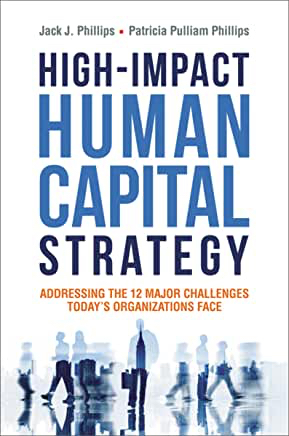By William Carmichael
Just when I thought return on investment analysis could not go any further, the ROI Institute surprises me once again. High-Impact Human Capital Strategy: Addressing the 12 Major Challenges Today’s Organizations Face by Jack J. Phillips and Patricia Pulliam Phillips is a tour de force that crafts a new direction for ROI aficionados and directs it where it rightly belongs; in HR’s background! This book focuses directly on how to develop an effective human capital strategy in today’s turbulent and constantly changing business environment. It also provides new meaning to the intangible levels of the ROI hierarchy by direct correlation to meaningful HR strategy.
HR Strategy vs. High-Impact Human Capital Strategy?
Where human capital (HC) strategy focuses primarily on recruiting, selection, talent management, compensation, motivation, compliance, and maintenance, High-Impact Human Capital Strategy was written as a guidebook for practitioners who want to go beyond traditional human resource management. The authors maintain that “no function, process, or issue in an organization is more important than the human capital managed by the HR department.” Further, HC strategy is critical to all organizations, whether public or private, for-profit or not-for-profit, and governments.” As an example, the authors contend that a major cause of the financial crisis in Greece stemmed from human capital issues manifested through bloated payrolls, excessive benefits, and a lack of accountability. For some in HR, these hit dangerously close to home.
12 Strategic Goals
The authors make a convincing argument that there are twelve forces that affect businesses and particularly in the human capital area; these being:
1) “Set the Proper Investment Level”- sets the optimal investment level for human capital and reviews this expenditure periodically.
2) “Align with Business Needs”- aligns HR programs to the business as they are initiated, developed, and implemented.
3) “Manage Talent for Value”- explains managing critical talent in the organization, ensuring that the appropriate number and quality of talented employees are available, addressing skills shortages, and ensuring that talent remains in the organization.
4) “Engage Employees at Work” – details pursuing a program of employee satisfaction, commitment, and job engagement, so that employees are fully involved in their work, remain loyal to the organization, and help attract others to the organization.
5) “Create a Performance and Innovation Culture”- describes creating a performance and innovation culture to achieve results in the organization with proper direction, roles, and motivations.
6) “Keep Employees Healthy”- advocates the importance of ensuring that employees are healthy and safe with proper healthcare and wellness opportunities.
7) “Embrace Demographics and Societal Changes”- addresses the current demographics and societal issues to ensure proper employee mix is available and included in processes to enhance productivity and innovation.
8) “Utilize Technology Effectively”- demonstrates using technology to its fullest extent to unleash the creativity and potential of employees, while ensuring that it is driving productivity, innovation, and customer satisfaction.
9) “Confront Globalization”- addresses globalization in terms of how it affects employees in the present and will affect employees in the future by having them actively engaged in every part of the process.
10) “Protect the Environment”- addresses environmental and energy issues as they relate to jobs, the organization, and society.
11) “Build Global Leaders”- emphasizes developing effective leaders who can operate successfully in a global, diverse environment.
12) “Use Analytics and Big Data”- proposes implementing a system for accountability, including measuring success with analytics and big data, and delivering value that will be credible to top executives, including the chief financial officer.
Structure and Layout
A relatively quick read at 304 pages, this book does not have to be read straight through in order to be valuable. However, for my audience here, I recommend reading Chapter 1 before reading any other chapter since Phillips and Phillips make a compelling argument for the necessity of HC strategy.
The book begins with two introductory chapters that set the stage for the remainder of the book which focuses on the 12 forces affecting business. Each chapter starts by defining the force, particularly in the context of how it affects HC and the business. Next, the force is detailed in terms of its elements, components, principles, issues, and challenges, including the effect it is having on organizations. The chapters are easy to read with the regular use of bulleted lists to highlight key items, tables, and graphs that ground the information. The 12 goals chosen by the authors align with their universally accepted ROI Methodology and other publications.
Additionally, reference information, including benchmarking sources and statistical examples (e.g. turnover calculations, sources of hard and soft data) are provided throughout the chapters. I have read and will continue to read books authored by Jack and Patti Phillips. Though some of the advice may seem to be common sense to those who have read their other works, it is always practical and actionable. It is this combination that makes the book a valuable read for HR professionals or anyone hoping to learn more about human capital strategy.
Who Will Benefit Most from This Book?
HR executives, managers, administrators, specialists, coordinators, and anyone involved in ROI analytics.
About the authors:
Drs. Jack and Patricia Phillips are Chairman and President/CEO, respectively, of ROI Institute. They are active consultants, prolific speakers, and co-authors of many HR books and articles. Jack and Patti Phillips have dedicated their professional lives to building accountability into human resources and training departments through the development of the ROI Methodology. 2The ROI Methodology has been used in over 66 countries and within a variety of Fortune 500 organizations across multiple industries.

Ed.D Professor | Strayer University
william.carmichael@strayer.edu
www.strayer.edu
